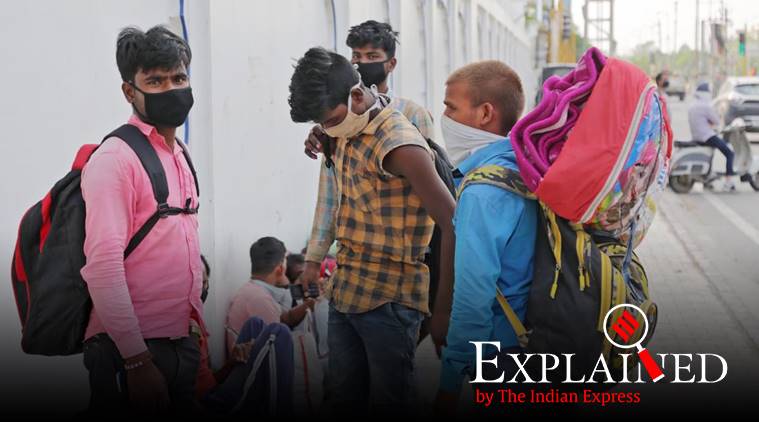- India
- International
Explained: Now online, a map tracking migrants, real time
The map matches “time and spatial data, on administrative facilities in the area, transportation and healthcare facilities of an area and summaries, on the fly, in real time of people passing by,” said Jagdeesh Rao, CEO of FES.
 Daily wage construction labourers start walking from Jamalpur in Ludhiana to Bhagalpur in Bihar. (Express Photo: Jasbir Malhi)
Daily wage construction labourers start walking from Jamalpur in Ludhiana to Bhagalpur in Bihar. (Express Photo: Jasbir Malhi)
India Observatory, an open-source database, has come up with a GIS-enabled dashboard that includes an India map reflecting the movement of migrants in real time on their long journeys, often on foot, along with facilities and relief organisations on their routes.
The platform, a collaboration with Foundation for Ecological Security (FES), Anand as its main nodal point, is called CoAST India (Collaboration/Covid Action Support Group). It draws information from 55 organisations on the ground, mostly in villages, and aims to make such data available so that it would enable governments and small local civil society groups to be of assistance.
The map matches “time and spatial data, on administrative facilities in the area, transportation and healthcare facilities of an area and summaries, on the fly, in real time of people passing by,” said Jagdeesh Rao, CEO of FES.
From ecology to migration
India Observatory was set up in December 2019, with FES focused on ecological issues about forests, water bodies, conservation, etc. that needed “a bird’s eye view or a satellite’s vision”. “We had started getting an ability to track natural habitat for all of India. We had data over 1,800 parameters which we mapped… But when Covid-19 broke out, hundreds of persons came forward and we decided to recraft the site to take into account movements of people, we formed a group called RCRC (Rapid Community Response to Covid). Placing all the information we have about resources and infrastructure on the ground, along with needs of people passing through or stopping over, needing food, financial support, medical care or facing any other threat, we have a proper grid available, updated regularly. So a click on the map can tell us of the people who are travelling, the issues they have and the resources of the area. The local groups can reach them and provide support.”
📣 Express Explained is now on Telegram. Click here to join our channel (@ieexplained) and stay updated with the latest

The governments of Jharkhand and Kerala shared data that enabled the map to get off the ground. On April 15, an Ecological Web of India became functional as the Migrant Map as they moved. Azim Premji Foundation, LibTech, IIIT Bengaluru, and the PHIA Foundation, and volunteers with the Stranded Workers Action Network and Revitalising Rainfed Agiculture (RRA) Network, helped found this. The data started with recording thousands of distress phone calls received, and was plotted on to a map.
What it contains
Four elements are sought to be brought together: location of migrants and vulnerable people, their specific needs, location of key infrastructure on the way which can double up as a rest-centre, or quarantine space and location of relief and rehabilitation providing NGOs and civil society organisations.
Rao emphasises the importance of open-source data at a time of crisis like this so that small groups that are efficient in small areas can help mitigate the disaster and not wait for big organisations or governments alone to make the moves.
Former ISRO chief A S Kiran Kumar, at a panel in Hyderabad where India Observatory was launched on December 3, 2019, spoke of the importance of developing geospatial data and the importance of it being available to all, government, civil society and industry, to enable its best use. But most data held by the National Disaster Management Authority or the Survey of India is usually treated as ‘strategic’ and is not available to the public at large.
The map is available free in 12 languages.
More Explained
EXPRESS OPINION
Apr 26: Latest News
- 01
- 02
- 03
- 04
- 05










































